By Dennis Reilly
Accounting for firefighters during a Mayday or a hostile fire event is probably one of most difficult tasks required of an incident commander (IC). These types of events create a limited window of opportunity to successfully rescue the members who are in danger. Any tool we can incorporate into our operations profile to assist with the accountability function deserves serious consideration. Let’s examine some relatively inexpensive but useful tools to help an IC rapidly account for members during a Mayday or hostile fire event.
Some of the items I will discuss might fit nicely into your organization, and some might not. This two-part series reflects the sum of my experiences; not everything I discuss is in place in all the organizations to which I have belonged. No one system is perfect, so find what works best for you. It is important during these discussions for leadership to put a quick halt to comments that go along the lines of: “I don’t like that,” “That is not the way we have always done it,” or “that does not look cool.” Do not let personal preference stand in the way of firefighter safety.
The items I will discuss are just pieces to the accountability puzzle. As much as I think marking coats, helmets, and self-contained breathing apparatus (SCBA) is very beneficial, these steps should support well-developed procedures, adequate staffing, and robust training. There are many experts in the field of human performance in the high-stress environment and they all speak to the need for realistic training and redundancy of systems; they also emphasize the danger that the overreliance on technology can create in a life-threatening event. Simple systems can be very effective.
RELATED FIREFIGHTER TRAINING
Count Off! Personnel Accountability When Advancing Hoselines
Fireground Accountability: Where Are We Failing?
Making Fire Service Accountability Work
Maintaining Accountability with Automatic Status Checks
This article will discuss my recommendations for helmet and bunker gear markings. Part 2 of this series will address SCBA marking. There are those who might question if the techniques I will describe with SCBAs will create issues with liability. I will address that in part 2 of this series. Everything I recommend with helmets and bunker gear are options available from most manufacturers.
Helmets tend to be the most recognizable piece of the firefighter ensemble. As such it is beneficial to be able to distinguish officers from firefighters. A different paint scheme for officer helmets will make the officer easily identifiable at an emergency scene. In the event of a Mayday or hostile fire event, the best way to account for all personnel might be polling the officers for the status of their members. Formalized accountability systems are great, but consider: are all the agencies on your alarm cards use the same system? Some places are fortunate to be able to answer in the affirmative, but the reality is many places cannot. Color coding of officer helmets will not be the absolute solution, but it is something that many places already do and is easy to implement.
Almost all helmets allow for some type of helmet shield. To enhance emergency scene accountability, it is wise to design a shield that will provide:
- Member’s name
- Member’s agency
- Member’s company assignment
- Identification of a member’s rank
All those items can easily be incorporated into the design of a helmet shield. There are many scenarios where officers and firefighters might not be able to communicate or respond to a personnel accountability report (PAR) request. Having all this information on a helmet shield will at least provide the means to do some type of head count as members are removed from a hazardous environment, even if they are not able to directly communicate their status. There are several National Institute for Occupational Safety and Health (NIOSH) Firefighter Fatality reports that detail incidents where it took hours to fully account for all the members operating at a scene. Any type of advantage an IC can get in determining the location and status of operating forces is worth considering.
For as many types of helmet shields out there, the passport type offers an enhanced level of accountability. Especially in the career service, one’s assignment can change by the day and sometimes by the hour. Each fire station in a department can keep an extra passport or two that has the company’s identifier. When a detailed member arrives at a temporary assignment, he or she can replace their regularly assigned company identifier with the temporary identifier. This might be somewhat cumbersome, but the benefits of being able to account for members during a Mayday or hostile fire event make the effort worthwhile. Company officers should be held accountable to ensure that all personnel under their command comply with the department’s standard for identification.
Most of what has been discussed is dependent of an individual’s permanent rank. The question about what to do with acting officers is bound to come up. With the costs of modern protective equipment, it is not feasible to have a spare officer’s helmet in every fire station. Even if this were possible, it would be impossible to have a helmet shield on the helmet that would include a member’s name. Identifying people by name is a critical part of the accountability process. By using different colored passports for company officers and having a spare officer’s passport available, an acting officer can replace their firefighter’s passport with the officer one. This is probably the best solution to the issue of acting officers. It might not fit all the criteria that have been discussed up to this point, but it is an attempt to do the best that can be done with limited financial resources.
The last item to consider is bunker gear marking. It is advantageous to have the organization’s name and the member’s name attached to the bunker coat. It is exceedingly rare for a firefighter in distress to lose their coat. If the coats are marked in this fashion a quick head count can be accomplished. This method might also help division/group supervisors with accountability of the resources assigned to them. As with all the other suggestions, these tools do not make up the total accountability system at an emergency scene, they are just pieces of a complex and difficult puzzle.
There is a cost factor attached to labeling helmet shields and coats with an individual’s name. As a cost containment step, some organizations might be inclined to label shields and coats with an agency specific line or identification number. This seems like a logical step but there is a huge drawback. In a crisis situation, there is a limited amount of information that can be processed at any one time. If the IC must stop and try to collate a number to a name, the stage is set for some confusion. Readily identifying people is crucial to the accountability function and as such all items of personal protective equipment that will be marked should be marked with a member’s name and not a line number. This one item is especially important if departments use automatic or mutual aid. An IC might readily recognize the line numbers of their staff, but what happens if their staff is involved in a hostile fire event in another agency’s response local? Do all agencies share name and line number rosters? How often are the rosters updated? It is easy to see using numbers instead of names can complicate an already difficult situation.
Some agencies have even gone a step further. Names have been added to the back of bunker pants and hook-and-loop patches with company identifiers are starting to be added to the sleeves of bunker coats. These enhancements just add another layer of redundancy to accountability efforts and are well worth the investment.
The bottom line: Every firefighter and company officer operating at an emergency scene should be equipped with a helmet shield that includes their name, agency, and company assignment. Their bunker coats should be marked with their name and agency name.
Company officers’ helmets should have a distinctive paint color that will identify them as an officer not a firefighter.
All the tools mentioned in this article have value in themselves, but their utility is greatly enhanced if adopted on a regional basis. Most localities have a regional chief’s association. Anyone who has been a firefighter for more than a month knows that change in the fire department tends not to happen quickly or without some amount of resistance. The ability to rapidly account for members at a Mayday or hostile fire event is vital to producing an effective outcome. Conversations among automatic and mutual aid partners concerning the steps outlined in this article should begin as soon as possible. The bottom line is if these steps can enhance firefighter safety, then they should be given serious consideration.
Part 2 will examine some ways to mark SCBA that will enhance emergency scene accountability.
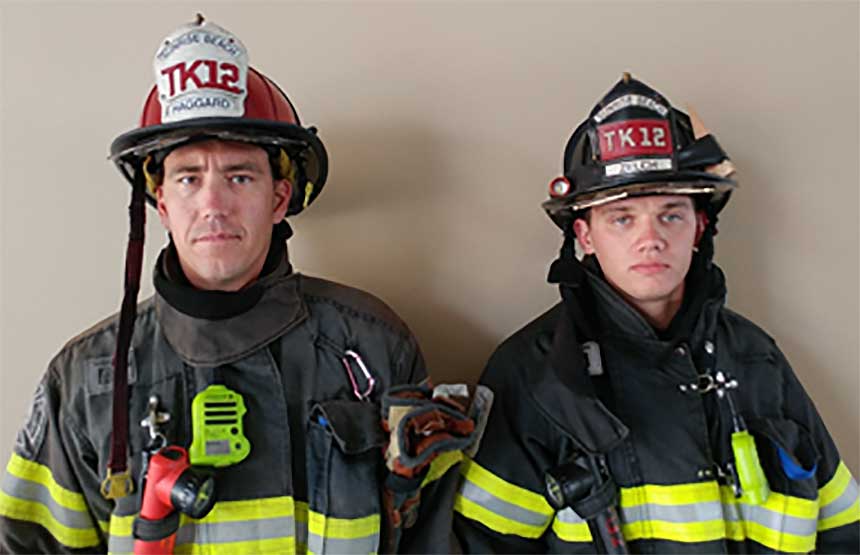
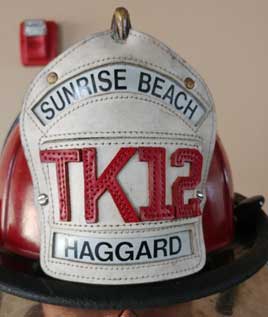
The white helmet shield identifies the wear as a company officer. The shield also identifies the organization, the company assignment, and the members name. 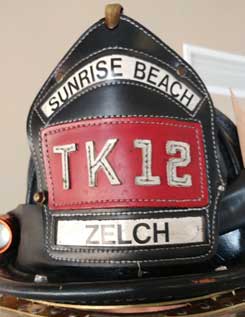
This helmet shield contains the same information as the officer’s, but the color scheme identifies the wearer as a firefighter 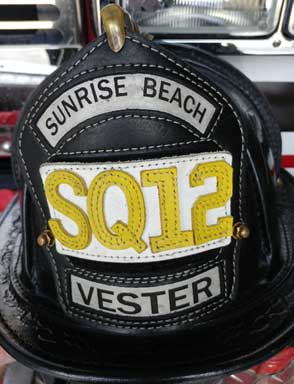
This picture shows the use of an officer passport on the helmet shield of a firefighter. This configuration can be used when a firefighter is used in the capacity if an acting officer.
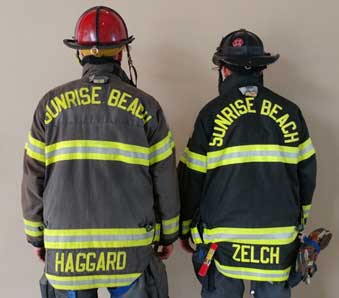
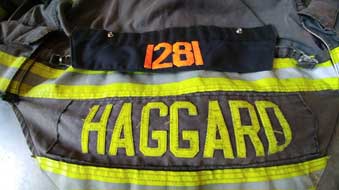
My thanks to some of the past & present members of the Sunrise Beach (MO) Fire Protection District for helping with the pictures used in this article.
Dennis Reilly is a 44-year veteran of the fire service and is currently the fire chief in Pittsburg, Kansas. Prior to moving to Kansas, he was the fire chief in Sunrise Beach, Missouri, and he is a retired battalion chief with the Cherry Hill (NJ) Fire Department. He was one of the original members of the New Jersey Urban Search & Rescue Task Force 1 and deployed to Ground Zero on 9/11. He holds an Master of Public Administration degree from Penn State and is a Chief Fire Officer. In addition to his fire service career, he is a combat veteran of the U.S. Army and worked as a private security contractor in Iraq and Afghanistan.

